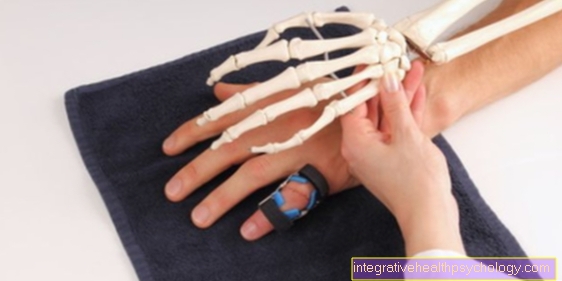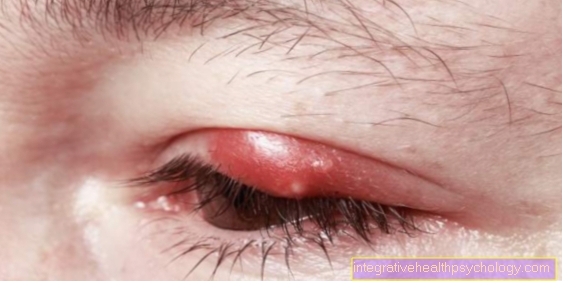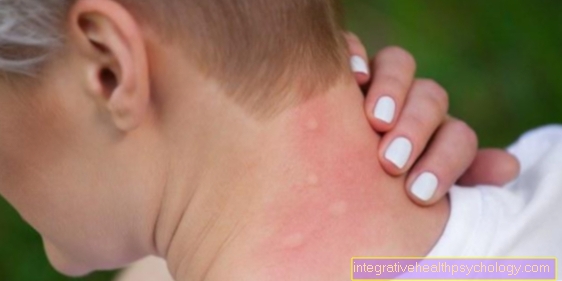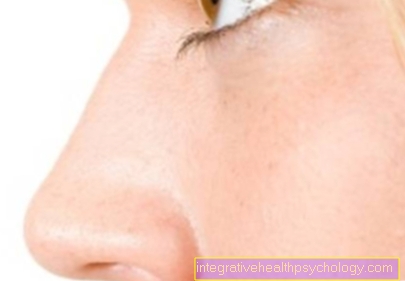Dog hair allergy
introduction
A dog's hair allergy is the hypersensitivity reaction of a person to contact with dogs. In contrast to cat hair allergies, dog hair allergies are rarely found. Nevertheless, it is estimated that up to 16% of the adult population suffers from a dog hair allergy.
Unfortunately, the term is somewhat misleading because the allergic reaction is not actually directed against the dog's hair itself, but primarily against certain substances that adhere to the hair, for example saliva, urine or dander.

The ingredient that most allergic reactions in sufferers are directed against is a protein called Can f1. This is known as the "allergen". It occurs to different degrees in different dogs, and some breeds even seem not to form it at all.
Dog hair allergy sufferers react differently to different dog breeds and also to individual dogs. This is due on the one hand to the differences just mentioned in the extent to which the protein is formed and on the other hand to other allergens in animals to which humans can react. In general, the allergen potential in long-haired breeds is not as high as in short-haired dog breeds.
For some breeds, for example boxers, allergies are described particularly often. In others, such as the Portuguese water dog, no allergic reactions have yet been detected.
Signs of a dog hair allergy
A dog allergy manifests itself through the typical symptoms of an allergy to substances in the air - these include watery and itchy eyes, runny nose, cough, itchy skin and hives. In principle, the allergy can begin at any age, although it usually occurs for the first time in childhood. Adults who have owned a dog for a long time can also develop a dog hair allergy. It is usually noticeable that there are more allergy symptoms in the dog's environment. But symptoms can also occur away from the dog, as the dog hair with the allergy-causing proteins can also be found on clothing and in the air.So it is not always easy to find out the primary cause of the allergy - an allergy test with a pulmonologist or dermatologist often has to provide clarity.
Read more on the topic: Cross allergy
Symptoms of dog hair allergy
Allergies are divided into types 1 to 4. The dog hair allergy is classified as type 1, the immediate type. As the name suggests, contact with the allergen leads to an immediate allergic reaction. The allergen, in this case a specific protein, is wrongly classified as dangerous by the person's body. This leads to a reaction of the immune system through which certain substances are released that lead to a typical allergic symptom complex. Histamine plays a particularly important role here.
The symptoms often depend on the point of contact between the person and the allergen. For example, if the allergens get in the eyes, they can cause itchy, reddening and swelling eyes. They may also water or swell.
With dog hair allergy sufferers, complaints of the nasopharynx are usually in the foreground. The irritation of the airways causes frequent sneezing and itching of the nose. The mucous membranes usually swell and the production of mucous membrane secretions is stimulated. There are frequent sneezing attacks and sometimes a burning sensation in the nose is described.
In contrast to people with hay fever, a dog's hair allergy also affects the skin in many cases. Patients get an itchy, red rash, which can also cause wheals (hives).
Dreaded long-term effects of a dog hair allergy are complaints in deeper areas of the respiratory tract. These occur above all if the allergy has existed for a long time and is not treated adequately. About a third of all untreated dog hair allergy sufferers are affected. These patients then additionally or exclusively suffer from what is known as allergic asthma. Coughing fits and a wheezing sound with shortness of breath occur.
The symptoms are particularly pronounced if the person concerned is in the immediate vicinity of a dog or in rooms where dogs are often present.
Symptoms on the skin
If a dog allergy sufferer comes into contact with dog hair, skin rashes can develop. So-called wheals, also known as hives, often occur. Wheals are small, usually rounded, whitish or reddish swellings that are very itchy. They are usually known from touching a nettle. They usually go away within minutes or hours, but can then reappear elsewhere. They are described in more detail in the next section. In addition to hives, so-called eczema can also occur. Eczema is a change in the skin that has small blisters, itches, is reddish in color, and flakes.
Rash
As noted, a common symptom of dog hair allergy is a rash. This can occur in a number of ways.
On the one hand there is the typical itchy rash with small red dots on the skin. These can be limited to a certain area of the skin or occur over a large area and on different parts of the body. The itchy skin causes the patient to scratch, which can worsen the reddening of the skin and also cause the skin to swell.
Another form of rash is the appearance of wheals on contact with the allergens. Wheals are point-like or larger plateau-like elevations on the skin. They are red and may also itch. They disappear on their own after a while.
Applying a moisturizing cream often helps against itching and redness. In general, you should avoid scratching if you have a rash, as this can cause the skin to react more violently and significantly swell. In most cases, the rash will then spread further. If the rash is very severe and in extreme cases even leads to open wounds, it should definitely be examined and treated by a doctor.
to cough
Coughing regularly is very common in people with a dog hair allergy. The reason for this is the irritation of the mucous membrane in the lungs or throat caused by inhaling some of the dog's hair. A dry cough without a lot of mucus secretion is typical at the beginning. In the course of time, however, especially if there is no therapy, allergic asthma with mucus secretion can develop.
If increased coughing occurs in the presence of a dog, the environment should be changed or an antiallergic drug should be taken.
However, it should not be forgotten that even in allergy sufferers, a cough can be caused by another cause, such as a typical cold.
Read more on the topic: asthma
Shortness of breath
If shortness of breath occurs as part of a dog's hair allergy, this is a sign of a very strong reaction. She should arrange for medication such as an antihistamine to be taken and see a doctor immediately. Without treatment, severe shortness of breath can lead to loss of consciousness and death. Difficulty breathing is usually caused by inhaling some of the dog's hair or swelling in the upper airways. It can also be a sign of the onset of a severe, whole-body allergic reaction that, if untreated, can lead to anaphylactic shock.
Dog hair allergy in the baby

If one of the parents is allergic, the risk for the child to develop allergies also increases. The risk increases when both parents are affected. It can also happen that a short time after the birth, an allergy to the house dog occurs. However, babies rarely develop an allergy to animal hair. It usually only begins with toddlers from the age of 2 or 3.
The complaints show up very differently. Symptoms such as a burning or itchy rash can appear on various areas of the skin. Eczema on the back, neck and face are also possible, as well as watery eyes and runny nose. Respiratory problems caused by a dog's hair allergy are particularly dangerous for young children. In addition to easy-to-hear rattle noises when breathing, the mucous membranes on the larynx can also swell and ultimately lead to life-threatening shortness of breath. The first signs of a possible allergic reaction to the pet should be closely monitored and eventually diagnosed by a doctor. Allergy tests are carried out to confirm.
Symptoms in the baby
Symptoms in babies are little or no different from symptoms in an older child or adult. Their eyes water and itch on contact with dogs. Babies often touch their faces as a result. They sneeze and have a runny nose. Babies cough when they inhale more of the dog hair and can develop breathing problems. These are often noticed when the baby is restless.
Dog hair allergy in the child
Approx. every 4th child suffers from an allergy. Animal hair is one of the most common triggers of allergic symptoms. The first symptoms usually only appear in older children - they usually only develop from the age of 2 or 3. In children, too, allergy to a dog is transmitted or caused by hair, skin, saliva, and urine. A dog hair allergy appears in children as in adults. The focus is on symptoms such as tears, runny nose, sneezing and rashes.
When treating a dog hair allergy in children, avoiding contact with dogs should be a priority. If a dog is kept as a pet and not given away, the allergy can worsen through constant and close contact and possibly lead to the development of allergic bronchial asthma. From 5th to 6th A so-called desensitization, also called “specific immunotherapy”, can be carried out at the age of 15. The child is repeatedly injected with allergens under the skin over a period of 3 years in order to get used to the substances. In the majority of children, the symptoms disappear completely.
Symptoms in the child
As already described, the symptoms of an animal hair allergy do not differ fundamentally in children and adults. Contact of the allergens with the mucous membrane of the eyes leads to itching and tearing of the eyes, inhalation through the nose leads to colds, a blocked nose and sneezing attacks. If the lungs are affected by inhaling hair components, symptoms of allergic asthma can also occur in children. Affected children have difficulty breathing and coughing and asthma attacks may occur. Exhaling is particularly difficult during a seizure - whistling noises are often audible. In more severe cases, the children are short of breath and have difficulty breathing.
When touching allergens, various skin rashes can occur even in children.
Read more on the topic: Allergies in children
diagnosis

The suspicion that there is a dog hair allergy is usually expressed by those affected themselves. In order to have this suspicion confirmed, it makes sense to consult a doctor. The symptoms can also be confused with the symptoms of other allergies or with bacterial or viral infections. The doctor usually first collects a detailed medical history.
Among other things, important questions are:
- What are the exact complaints?
- How often and when exactly do they occur?
- Can they be triggered by certain activities / situations?
- Can certain activities / situations improve or make them worse?
- Do other family members have similar symptoms?
- Are there any other known diseases and / or allergies?
This is followed by a physical examination. During this, the doctor examines the eyes, nose and paranasal sinuses and, if necessary, the affected skin areas.
After initial examinations, a suspicion has usually already been established, but can then be confirmed by certain tests. There are various skin tests that can be used to detect allergies.
The so-called prick test is the most common. In this test, the doctor applies various allergens, diluted in solution, to the patient's forearm, which are relevant for the symptoms. Then he pierces the skin with a small lancet in the middle of the droplets so that the allergens get into the body.
An allergic reaction has occurred in those areas where redness and / or wheals appear within ten to twenty minutes. If the result is unsatisfactory, the prick test can be supplemented with an intracutaneous test. Here, the allergens are injected directly under the skin, which makes this test more accurate, but also more painful.
A blood test can also provide information about a questionable allergy. As a rule, however, it is only carried out if the prick test cannot be carried out for any reason or if the results are unclear. Blood is taken and examined in the laboratory for a specific antibody subtype (IgE, which is increasingly released in the context of allergic reactions). Here you can measure the total IgE, i.e. all IgE antibodies that are present in the blood. However, this is only of limited significance as it can also be increased by other factors (such as worm infections or smoking).
It is better to determine the specific IgE. This is directed against a specific allergen, in this case a dog hair allergen. If this value is increased, it speaks almost 100% in connection with the appropriate clinical picture in favor of an existing dog hair allergy.
A final option is the provocation test. In this test, the patient is confronted directly with the suspected allergen, for example it is brought into contact with the mucous membrane of the eye or nose. Since this test can sometimes cause severe allergic reactions, it is rarely used and must only be carried out under strict supervision.
Important differential diagnoses of a dog hair allergy are other allergic diseases, for example hay fever, allergies to other animal hair, food allergies or allergies to drugs. Some infections (viral, bacterial or worm), certain changes in the nasopharynx or even hormonal disorders can cause comparable symptoms. For this reason, a thorough diagnosis is essential, even in apparently clear cases of dog hair allergy.
Dog hair allergy test
An allergy to dog hair can already be recognized by talking about the occurrence and type of complaints. However, a definitive diagnosis should only be made after further testing. The most commonly used is the so-called prick test. In this test, as already described, possible allergens are applied to the skin on the forearm and the skin is slightly scratched. In the case of an existing dog hair allergy, the skin would react at this point. It would blush within 15-20 minutes and possibly form typical wheals. The test would be positive. In addition to this test, a blood test can be done. The RAST test examines the patient's blood for antibodies, which are increasingly formed in the event of an acute infection. The provocation test is not used too often these days. The allergens are applied directly to the nasal mucous membrane, for example, and a direct reaction occurs. However, since the allergic reaction here is very strong and can also lead to threatening situations, the test is rarely carried out.
Read more on the topic: Allergy diagnostics
Dog hair allergy therapy - what to do?

The most important component of therapy against dog hair allergy is the consistent avoidance of contact with the allergen ("allergen avoidance").
If possible, those affected should not keep their own dog and should also keep contact with the animals as low as possible in other areas of life. However, it is often very difficult for people who become ill late to part with a pet. If you decide to buy a dog with a known allergy, you should find out all about allergy-friendly breeds.
Since the dog hair allergen is not as small and typically does not settle as stubbornly as the cat hair allergen, for example, one can try to counteract the dog hair allergy with extensive hygiene measures. It is particularly important to vacuum all carpets and upholstered furniture frequently (preferably with a fine dust or water filter).
In addition, the dog should have as little contact as possible with textiles in which hair can easily get stuck. In addition, it is advisable not to let the dog into the bedroom in order to allow the body at least a rest period at night. In addition, you should make sure that you comb and wipe your dog frequently to reduce loose allergens as much as possible.
However, all these measures are usually not able to completely remove dog hair from an apartment. Therefore, additional medication must often be used to get the symptoms under control. For allergies in general, antihistamines are usually prescribed, which are in the form of:
- Tablets
- Anoint
- Eye drops and nasal drops are available.
Which of the many preparations works best in which dosage must be decided individually. It can sometimes take some time to find the optimal application mode. But even if this therapy often helps relatively well, it is purely symptomatic.
Desensitization
If you want to approach the problem causally, ultimately only a desensitization (also: desensitization) in question. Desensitization, technically known as specific immunotherapy, is used to combat hypersensitivity in dog hair allergies. It is the only causal form of therapy - if it is successful, the allergy is practically cured. Symptoms no longer occur after contact with dogs. The success rate of desensitization is very high in dog hair at over 80%. The symptoms can be significantly alleviated in almost every patient treated.
In desensitization, small amounts of allergens are repeatedly introduced into the body over a period of at least 3 years. It is usually injected into the skin and administered in constantly increasing doses up to a certain maximum dose. This leads to a tolerance to the allergen. With renewed contact, the body reacts much weaker. The treatment promises success, especially at a young age.The reason for this is that the immune system in children is still very capable of learning and changing. In addition, the success rate is higher if sufferers have only a few allergies at the same time. Since injections are often not accepted by children before the age of 5 or 6, they are usually only treated from the age of 6.
While this procedure has become well established and proven in the case of cat hair allergies, it is not yet certain whether it will also work well for dog hair allergies. Therefore, this treatment is not yet covered by many health insurance companies. In general, it only comes into question if the person concerned does not have a dog in the household, otherwise success can be almost excluded.
Further information is available under our topic: Desensitization
homeopathy
In homeopathy too, dog allergies should primarily be treated by avoiding the dog. Since dog allergies are usually weak, the recommended therapeutic measure in homeopathy is the Keep your dog outside, not in the house. A well-tested drug that has a causal effect on dog hair allergy is not known in homeopathy.
It can, however various globules to reduce symptoms can be used. This includes treating itchy eyes, watery eyes, sneezing and runny nose, for example Globules with Euphrasia (eyebright), Lime sulfur liver, Allium cepa (Onion) and Galphimia glauca (Golden rain).
It is important to understand that the active ingredients in the globules are only present in minimal quantities due to a strong dilution. As with practically all homeopathic medicinal products, their effectiveness has not been proven by reliable studies. If the symptoms persist despite the use of homeopathic globules, it is recommended to use other forms of therapy.
Which dogs are suitable for me if I have a dog hair allergy?
The breed of dog itself does not affect the allergens or the allergic reaction of humans. In principle, the dog's hair allergy does not depend on the breed of the dog, but on the allergy and the reaction of humans. All dogs have the typical proteins that act as allergens in their saliva and skin. Only when the hair spreads can the allergens spread in the household. For this reason, dog breeds that release the same amount of allergens but lose less hair are more suitable for allergy sufferers.
The hairless dog is therefore best for allergy sufferers. However, since this is not an option for all dog owners, long-haired dogs are preferable to short-haired ones because they experience a slower coat change. Also suitable are water dogs such as the Spanish and Portuguese water dog, as well as the poodle. The Labradoodle and the Goldendoodle are also typical dogs with allergies. They are multiracial dogs that are not entirely free of coat loss and are therefore only an alternative for those with mild allergies. It is similar with the Bedlington Terrier and the Yorkshire Terrier.
Since allergies can vary greatly between different people and between the individual dog breeds, a trial test should always be carried out before buying the dog. The easiest way to detect reactions to the animal's hair is to carefully sniff the dog. Allergy tests by a doctor can also determine the extent of the allergy quantitatively.
This could also be of interest to you: Which dog fits me best?
Which cross allergies are possible with a dog hair allergy?
A cross allergy is an allergy to a foreign substance whose allergen is similar to an existing allergy. So if you suffer from a dog hair allergy, you may also be allergic to other messenger substances, as these are similar to the dog's saliva protein.
The dog hair allergy is mainly associated with animal hair allergies to other animals. Allergies to cat or mouse hair are particularly common. Again, it is saliva and skin proteins that get into the hair.
The severity of the allergy can vary greatly for each animal and allergen, which is why general statements cannot be made.
You can also find out more at: Cat hair allergy
Recommendations from the editorial team
- Pet hair allergy
- Food allergy
- allergy
- Allergy diagnostics
- Nickel allergy
- Cat hair allergy
- Food poisoning
- Lactose intolerance
- Sun allergy
- Allergy therapy

























.jpg)



